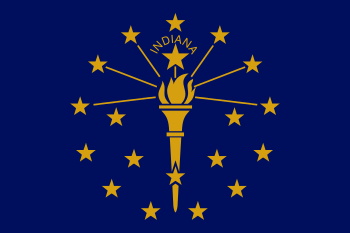Monon Railroad
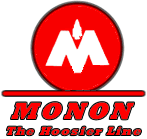 | |
|
A postcard depiction of the Thoroughbred, with an EMD F3 in the lead. | |
| Reporting mark | CIL, MON |
|---|---|
| Locale | Illinois, Indiana, and Kentucky |
| Dates of operation | 1847–1971 |
| Successor | Louisville and Nashville |
| Track gauge | 4 ft 8 1⁄2 in (1,435 mm) |
| Headquarters | Chicago, Illinois |
The Monon Railroad (reporting mark MON), also known as the Chicago, Indianapolis, and Louisville Railway (reporting mark CIL) from 1897 to 1956, was an American railroad that operated almost entirely within the state of Indiana. The Monon was merged into the Louisville and Nashville Railroad in 1971, and much of the former Monon right of way is owned today by CSX Transportation.[1] In 1970 it operated 540 miles (870 km) of road on 792 miles (1,275 km) of track; that year it reported 1320 million ton-miles of revenue freight and zero passenger-miles. (It showed zero miles of double track, the longest such Class I railroad in the country.)
Timeline

- 1847: The New Albany and Salem Railroad is organized with James Brooks as president.
- 1854: The NA&S trackage stretches from the Ohio River (at New Albany) to the Great Lakes (at Michigan City).
- 1859: The overextended and struggling NA&S is renamed the Louisville, New Albany and Chicago Railroad (LNA&C).
- April 30, 1865: The LNA&C becomes one of twenty railroads to haul Abraham Lincoln's funeral train, from Lafayette, Indiana to Michigan City, Indiana.
- 1873: The LNA&C Railroad is reorganized as the Louisville, New Albany and Chicago Railway.
- 1881: The LNA&C consolidates with the Chicago and Indianapolis Air Line Railway, and the trackage of the new division is soon extended to reach into its namesake cities.
- July 1, 1897: The LNA&C is reorganized as the Chicago, Indianapolis, and Louisville Railway.
- 1932: The 300 pound (136 kg) Monon Bell is first presented as the trophy of the annual football matchup between DePauw University and Wabash College.
- 1946: John W. Barriger III becomes President of the Monon, bringing aggressive plans for modernization.
- June 29, 1949: Final day of steam locomotive service, as the Monon becomes one of the first Class I railroads to fully convert to diesel motive power.[2]
- January 11, 1956: The CI&L officially adopts its longtime nickname, Monon, as its corporate title.
- 1959: The Monon's passenger service between Chicago, Illinois and Indianapolis, Indiana is discontinued. By 1965, only the Thoroughbred remained, with its single daily roundtrip from Chicago to Louisville.
- September 30, 1967: Final day of regularly scheduled passenger train service on the Monon.
- March 21, 1968: Merger with Louisville and Nashville Railroad announced to placate Monon fears of lost business due to L&N's acquisition of a competing route, the Chicago and Eastern Illinois Railroad.[3]
- July 31, 1971: The Monon is merged into the Louisville and Nashville Railroad.
- 1999: Portions of the line around Indianapolis were converted to a bicycle and pedestrian trail known as the Monon Trail.
Colleges served
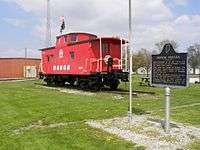
The Monon served six colleges and universities along its line:
- Purdue University in West Lafayette, Indiana
- Wabash College in Crawfordsville, Indiana
- DePauw University in Greencastle, Indiana
- Indiana University in Bloomington, Indiana
- Butler University in Indianapolis, Indiana
- St. Joseph's College in Rensselaer, Indiana
The university traffic was important enough to the Monon that the railroad used the schools' colors on its rolling stock. The red and white of Wabash College (and similar to the colors of Indiana University) was used on the railroad's passenger equipment, and the black and gold used by both DePauw University and Purdue University adorned the railroad's diesel freight locomotives and later replaced the red and white on passenger equipment as well.
Genealogy
- Monon Railroad[4]
- Chicago and South Atlantic Railroad 1879
- Chicago, Indianapolis, and Louisville Railroad 1956
- Chicago and Wabash Valley Railroad 1914
- Indianapolis and Louisville Railroad 1916
- Louisville, New Albany and Chicago Railroad 1898
- Bedford and Bloomfield Railroad 1886
- Chicago and Indianapolis Air Line Railway 1883
- Indianapolis, Delphi and Chicago Railroad 1881
- New Albany and Salem Railroad 1873
- Crawfordsville and Wabash Railroad 1852
- Orleans, Paoli and Jasper Railway 1886
Monon route
.jpg)
The railroad got the name Monon from the convergence of its main routes in Monon, Indiana. From Monon, the mainlines reached out to Chicago, Louisville, Indianapolis, and Michigan City, Indiana.[1] In Chicago the Monon's passenger trains served Dearborn Station. Branches connected the Louisville mainline to Victoria, Indiana and French Lick, Indiana.
The Monon's main line ran down the middle of streets in several cities, notably Lafayette, New Albany, and Bedford. It also installed an unusual "home grown" warning signal at many grade crossings; these used a green signal light (similar to and adapted from a standard highway traffic signal) that stayed lit at all times, except when a train was approaching. A sign below or to the side of the signal read, "STOP When Signal Is Out." This design was fail-safe, in that when the signal bulb was burned out, an approaching vehicle driver would assume a train was coming — until he eventually realized there was no train and just a burned-out signal.
The Monon had seven sections. Beginning in the north, Section One was from the Indiana line to Lafayette, passing through the Monon switch in Monon. As a primary passenger route, it connected to Section Four running between Lafayette and Bloomington. This route reached the Ohio River over Section Five from Bloomington to New Albany. From this southern route, Sections Six and Seven were spurs to the west. Section Six served the coal fields between Midland and Clay City, connecting to the main line at Wallace Junction, just south of Cloverdale. Section Seven provided passenger service to the resort hotels in West Baden and French Lick, through a connection at Orleans.
The other primary line, mainly a freight line, included Section Two from Michigan City on Lake Michigan to Monon and then Section three from Monon to Indianapolis. Although each route had its primary traffic, freight and passengers were carried over all parts of the line.
Section #1
Chicago to Lafayette[5] The Chicago to Lafayette route is used by Amtrak for the Cardinal and the Hoosier State.[6]
- Chicago – Dearborn Station.
- Englewood
- Hammond, here, the Monon entered Indiana and track ownership belonged to the Monon line. From Chicago to Hammond, the Monon may have owned the tracks or rented them from other lines in Illinois.
- Munster
- Dyer
- St. John
- Cedar Lake
- Lowell
- Shelby
- Thayer
- Roselawn
- Fair Oaks
- Rensselaer, home of St. Joseph College

- Pleasant Ridge
- McCoysburg
- Lee
- Monon, the central switching yard for all trains, and company namesake
- Reynolds
- Chalmers
- Brookston
- Battle Ground
- Lafayette, rail station of Purdue University, located across the Wabash River in West Lafayette
Section #2
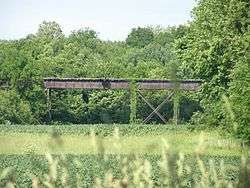
Monon to Indianapolis.[5] Section #2 was a freight route between Monon and Indianapolis. The section of the line between Monon and Monticello is still in service. The rest has been completely abandoned and the rails removed. Much of the right-of-way has been returned to neighboring landowners. Where farm fields surround it, evidence of the route has nearly been obliterated as the land has been returned to farming. On the north side of Indianapolis and in Carmel and other cities in Hamilton County the Monon Trail is a bike and walking route following the right-of-way.[7]
- Guernsey
- Monticello
- Yeoman
- Delphi
- Radnor
- Ockley, south of Ockley station, the viaduct over Wildcat Creek still existed until 2013. It was just north of Owasco and was visible from US 421/SR 39. In 2004, it was damaged by heavy run-offs in Wildcat Creek, which moved the legs of the steel piers out of alignment. It was still standing until the summer of 2013 when it was dismantled by CSX.[8]
- Rossville
- Frankfort
- Kirklin
- Sheridan
- Westfield
- Carmel; see Carmel Monon Depot
- Nora
- Broad Ripple[9]
- Boulevard Station
- Indianapolis, home of Butler University. The Monon used the Indianapolis Union Station in downtown Indianapolis.
Section #3
Michigan City to Monon[5] This line runs parallel to U.S. 421 as far as Brookston. The Indiana Rail to Trails group is developing a bike route from Michigan City to La Crosse, using the Monon right-of-way, where it still exists. A section south of Michigan City by I-94 has been consumed by a landfill and the bridge over the interstates I-94 and I-80/I-90 have been removed.
- Michigan City
- Otis
- Westville
- Aldo
- Haskell
- Wanatah
- South Wanatah
- La Crosse
- Wilders
- San Pierre
- Medaryville. North of Medaryville the tracks have been abandoned and removed. The line is still in service from Medaryville to Monon.
- Francesville
- Monon
Section #4
Lafayette to Bloomington[5] From Lafayette southward, the Monon follows along U.S. 231 to Crawfordsville. At Crawfordsville, the right-of-way moves eastward of the highway several miles, but continues south to Cloverdale, returning closer to U.S. 231 at Greencastle. Amtrak uses this route south to Crawfordsville and then the old New York Central/Conrail tracks into Indianapolis.
- Lafayette, home to Purdue University
- South Raub
- Romney
- Linden now hosts a museum of the Monon Line in the old station.
- Crawfordsville home of Wabash College
- Ladoga
- Roachdale
- Bainbridge
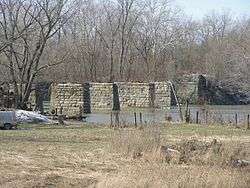
- Greencastle, home of DePauw University
- Limedale
- Putnamville
- Cloverdale The tracks from Lafayette end here.
- Wallace Jct provided access to the coal fields of Midland, Howesville and Clay City along Section Six of the Monon line.
- Quincy
- Gosport – South of Gosport, the Monon crosses the White River.
- Stinesville is the northern edge of quarry country. From here, south through Bedford and Mitchell, quarries of fine Indiana Limestone exist.
- Adams
- Ellettsville, tracks end here from Bloomington
- Bloomington home of Indiana University
Section #5

Bloomington to New Albany[5]
- Bloomington home of Indiana University. Tracks from south of the junction with INRD have been removed and converted into a trail within the Bloomington city limits.
- Clear Creek
- Harrodsburg
- Guthrie
- Murdock
- Bedford Tracks resume here.
- Mitchell
- Orleans is where the junction to Section Seven used to be. It headed southwest towards West Baden and French Lick
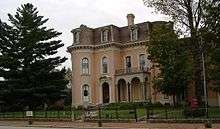
- Leipsic
- Campbellsburg
- Hitchcock
- Salem
- Farabee
- Pekin
- Borden
- New Albany
Section #6
Wallace Jct. to Midland (coal fields)[5] With the exception of a short stretch from Midland Junction to Vicksburg, this section has been completely abandoned and the tracks have been removed.
- Wallace Jct
- Cataract
- Jordan
- Patricksburg
- Clay City
- Howesville
- Midland, east entrance to the Indiana coal fields. The active mines are between Linton, Jasonville, and Sullivan.[10]
- Vicksburg
- Victoria has disappeared as a community.[10]
Section #7
This section has been completely abandoned. Tracks only remain in French Lick and is used as an excursion route. French Lick to Cuzco. A portion of the original track in French Lick and West Baden(between the West Baden Hotel and the Indiana Railway Museum) has been altered and expanded for a trolley service serving various locations of the French Lick Resort and the museum.
The line today
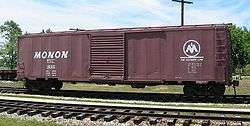
The remains of the line are operated by CSX Transportation. Large segments have been abandoned in recent years: most of the line from Monon southeast to Indianapolis, the line north from Monon to Michigan City, and the line segment between Cloverdale and Bedford (this segment was abandoned due largely to a washout). A portion of the French Lick branch is now home to a railroad museum, with part of the line wired for trolley service.
Between Bedford and Mitchell, CSX owns the line but does not operate any of its own trains. Until 2010, the only service came from trains of the Indiana Rail Road, which in 2006 purchased the former Latta Subdivision of the Canadian Pacific Railway, which connected with the former Monon at Bedford. INRD operated over the old Monon from Bedford to Louisville through trackage rights negotiated by the Latta Sub's original owner, The Milwaukee Road, when the L&N took over the Monon. Those trackage rights went from the Milwaukee Road to its buyer, The Soo Line Railroad; a subsidiary of the Canadian Pacific Railway. In May 2010, INRD ended service and removed trackage from the former Monon junction in Bedford to the Naval Surface Warfare Center Crane Division west of Bedford. Consequently, CSX placed the ex-Monon line from Bedford south to Mitchell out of service.
CSX does operate trains between Louisville and St. Louis, Missouri over the Louisville-Mitchell segment; these trains have to make an unusual reverse movement to go from the Monon to the former Baltimore and Ohio Railroad line to St. Louis, owing to an unfavorable track arrangement at the crossing of the lines in Mitchell. As of 2010, CSX has stopped making regular movements over the line, with trains being shifted to the nearby Louisville and Indiana Railroad via a trackage rights agreement.
.jpg)
The Monon's original semaphore signals are still in operation between Salem and Mitchell. These are some of the last semaphore signals remaining in mainline operation in the United States. From Crawfordsville to near Lafayette, some semaphore signals were removed in 2009, however several are still in service, including two sets in Crawfordville, with their replacement signals adjacent for the day CSX makes the conversion (as of November 10, 2010).
Amtrak's combined Cardinal and Hoosier State trains traverse the former Monon from Crawfordsville to the Indiana state line near Chicago, with one train in each direction daily. Station stops along the former Monon include Lafayette, Rensselaer, and Dyer.
The line through Lafayette was relocated in 2000 to an alignment along the Wabash River, parallel to the similarly relocated Norfolk Southern Railway line. Previously, the Monon Line ran down the middle of Fifth Street, with a hotel serving as its passenger station well into the Amtrak era.
The Monon Line has been abandoned in Hammond and Munster north of the junction with the Grand Trunk Western Railroad, and the corridor is being considered as part of the Northern Indiana Commuter Transportation District's proposal for the West Lake Corridor to Lowell and Valparaiso, Indiana.[11]
All of the Monon's street running segments remain, except for the relocated Lafayette trackage. The last of the Monon's green-light grade crossing signals was apparently removed from service at a crossing a few miles north of New Albany in 2004, though this cannot be confirmed as the last such installation — many of those signals were installed on lightly traveled roads, out of notice of all but the most dedicated railfans.
Museums of the Monon Line
The Indiana Railway Museum in French Lick operates trains south from French Lick to Cuzco, Indiana, out of the former Monon (Union) depot in French Lick, Indiana.[12]
The Monon Connection, which opened in 2005. is on U.S. 421 north of Monon.[13]
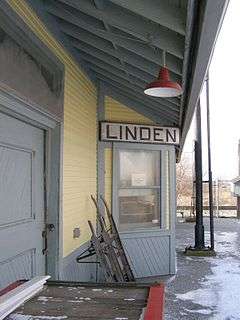
Located in a disused Monon Railroad Station, the Linden Railroad Museum is run by the Linden-Madison Township Historical Society. In 1852 the Michigan City, Salem and New Albany (later Monon) Railroad cut through Montgomery County. The old stage road between Crawfordsville and Linden was given to the railroad as an inducement to get them to build through Linden. 1852 also saw the building of the first Linden depot, on a site behind the present day Post Office. The building was moved to the current location in 1881 when the Toledo, St. Louis and Western Railroad was built through Linden, crossing the Monon at this location. The museum is owned by the Linden-Madison Twp. Historical Society.[14]
The John Hay Center in Salem has the Depot Railroad Station Museum, honoring the Monon. It has also been the home of the Monon Railroad Historical/Technical Society since summer 2012.[15]
Carmel, just north of Indianapolis, hosts the Monon Depot Museum.
The Kentucky Railway Museum in New Haven, Kentucky displays Monon's Diesel Engine No. 32, an Electro-Motive Division (EMD) BL2 model, in its original black and gold paint scheme.
The Indiana Transportation Museum in Noblesville, Indiana operates the Monon's first owned and operated diesel, SW1 No. 50.
See also
- John W. Barriger III
- CSX Transportation, successor to the Monon line
- Monon Bell, trophy between Wabash College and Depauw University
- The Boilermaker Special, the official mascot of Purdue University in West Lafayette, Indiana. A brass bell and steam whistle were donated to Purdue University by the Monon Railroad in 1940 for installation on the original Boilermaker Special I. The brass bell is still in use on the current Boilermaker Special V.
References
- 1 2 Historic Marker in Monon, erected by the Monon Historical Society, 1982
- ↑ "One of the first". Monon Railroad Historical-Technical Society, Inc. 2012. Retrieved June 29, 2015.
- ↑ http://archives.chicagotribune.com/1968/03/22/page/71/article/monon-l-n-roads-act-to-merge
- ↑ RAILROADS IN NORTH AMERICA; Some Historical Facts and An Introduction to an Electronic Database of North American Railroads and Their Evolution by M. C. Hallberg (April 24, 2006)
- 1 2 3 4 5 6 Monon, the Hoosier Line and connections; undated, predates, 1970s
- ↑ Amtrak Route Guide, 2008
- ↑ Google Earth
- ↑ "Bridgehunter.com: Historic Bridges of the United States".
- ↑ Indianapolis Map, AAA, 2006
- 1 2 Google Maps, Victoria, Indiana
- ↑ http://www.nictd-wlc.com/
- ↑ French Lick Scenic Railway Museum - Home Page
- ↑ "Mononconnection".
- ↑ The Linden Depot Museum
- ↑ The Depot Railroad Museum
16. Rhymed Americana by William O. Thomson, 1967. Poem "The Monon Route."
Further reading
- Dolzall, Gary W., and Dolzall, Stephen F. Monon: The Hoosier Line, Interurban Press (1987).
- Hilton, George. Monon Route, Howell-North Books (1978).
- Longest, David, "The Monon Railroad in Southern Indiana", 2008, Arcadia Publishing
External links
| Wikimedia Commons has media related to Monon Railroad. |
- Monon Railroad Historical-Technical Society
- List and Family Trees of North American Railroads
- Tom Kepshire's Bygone Places Along the "Hoosier Line" site
- Bygone Places Along The Monon
